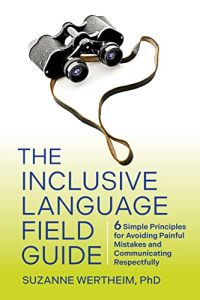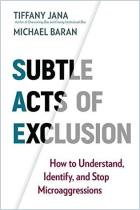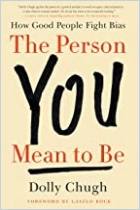Зарегистрируйтесь на getAbstract, чтобы получить доступ к этому краткому изложению.

Зарегистрируйтесь на getAbstract, чтобы получить доступ к этому краткому изложению.
Suzanne Wertheim
The Inclusive Language Field Guide
6 Simple Principles for Avoiding Painful Mistakes and Communicating Respectfully
Berrett-Koehler, 2023
Что внутри?
Deftly navigate evolving rules of language etiquette by following six inclusive language principles.
Recommendation
Today’s language etiquette includes words and phrases that might seem strange or awkward. Dismissing these changes as political correctness gone mad is easy, but language continually evolves to reflect changing attitudes. Words that you find innocuous can offend others. To forge connections and facilitate trust, consider the needs, feelings and preferences of those who have been marginalized in the past. Embrace linguistic anthropologist Suzanne Wertheim’s six principles of inclusive language to better understand the dynamics of communication and avoid hurting others with your words.
Take-Aways
- The six principles of inclusive language provide a communication framework that engenders connection and trust.
- Dictionary definitions don’t encompass the nuances of what a word conveys in context.
- “Reflect reality” with language that respects growing social awareness of the gender continuum.
- “Show respect” by avoiding “unconscious demotions” and by using people’s preferred name, pronoun and honorific.
- “Draw people in” with inclusive language that avoids marginalizing the differently abled.
- “Incorporate other perspectives” to acknowledge other people’s lived experiences.
- “Prevent erasure” by eradicating language that overlooks entire groups of people.
- “Recognize pain points” to eliminate triggers that reveal false assumptions and biases.
Summary
The six principles of inclusive language provide a communication framework that engenders connection and trust.
Some words and phrases that you have used for years might now be socially unacceptable. People expect you to use inclusive and considered language and to think about the feelings and preferences of those you’re addressing – particularly when speaking to historically marginalized groups or individuals. A single word or misguided phrase can cause irreparable harm in such contexts.
“Every time you use language to interact with someone, you are affecting your relationship with that person. Every single thing you say or write can cause a relationship to improve or deteriorate.”
Today’s more inclusive reality often feels like a minefield, especially if you aren’t up-to-date on 21st-century language etiquette. The six principles of inclusive language provide the tools to navigate this new terrain and interact confidently. Even as language evolves and contexts shift, these scientific concepts can help you understand communication dynamics. Use them to sidestep faux pas and avoid unintentionally hurting others with your words.
Dictionary definitions don’t encompass the nuances of what a word conveys in context.
Linguistic anthropologists examine words through three lenses:
- “Semantic frames” – A single word can conjure a complete image in your head. Seemingly synonymous adjectives illustrate how framing creates double standards and biases: for instance, a “high-spirited” versus a “disruptive” child; “tousled” versus “unkempt” hair; and an “aggressive” versus an “assertive” personality. One discrimination lawyer urges her clients to “report” sexual harassment rather than lodge a “complaint.” A “complainer” is seen as negative and emotional, while a “reporter” presents as objective and rational.
- “Indexicality” – Words carry cultural meanings that transcend dictionary definitions. Societies index the words of those in power as more positive and acceptable. For example, in the United States, the word “snowflake” is a derogatory term toward someone with left-leaning political beliefs.
- “Flavor” – Words are not neutral. A word absorbs a flavor, depending on its context, that extends beyond its dictionary definition. For instance, the word “exotic” might seem innocuous to many people. But for others, including Shirin, an Iranian-American woman, being described as exotic makes her feel like an outsider and often carries unwanted sexual connotations. When Shirin asked her friend Rob to stop referring to her as exotic, he reacted insensitively. He told Shirin that she was being overly emotional and added that he couldn’t understand why she had a problem with the word since he did not.
“Dictionaries are great! But they don’t reveal everything you need to know about how a word is working out there in the world.”
Semantic frames, indexicality and flavor are valuable perspectives for helping you identify problematic language. They can aid you in living out the six principles of inclusive language: “reflect reality, show respect, draw people in, incorporate other perspectives, prevent erasure” and “recognize pain points.”
“Reflect reality” with language that respects growing social awareness of the gender continuum.
Pronouns may seem inconsequential, but they carry great weight, particularly among those whom people routinely misgender. Inclusive language reflects scientific reality by recognizing that gender identity is not binary. This language uses respectful terminology that incorporates that awareness. Get acquainted with the new normal by understanding the difference between “gender identity, gender expression and sexual orientation”:
- Gender identity – A person whose birth sex and gender identity are aligned is considered to be cisgender. Someone whose birth sex and gender are not aligned is either nonbinary – someone who might have female and male characteristics or who is gender fluid, feeling at times male and at other times female – or transgender – someone who feels that their birth sex does not match their gender identity. Speak inclusively by using the gender terms people ascribe to themselves. Using only the pronouns “he” or “she” excludes people who don’t fit into these binary categories. Additionally, become accustomed to stating your pronouns when introducing yourself.
- Gender expression – Gender expression refers to external cues people use to signal gender, which may or may not align with the sex assigned to them at birth.
- Sexual orientation – Sexual orientation pertains to sexual attraction and is unrelated to a person’s gender. People can fall anywhere on the sexual orientation continuum. They may be heterosexual, lesbian, gay, bisexual, pansexual or asexual – that is, not interested in intimate relationships. Sexual orientation does not determine pronouns or gender.
“In order to be polite in today’s world, it’s important to use pronouns that reflect reality – along with gender terminology that is accurate and respectful.”
Three types of linguistic distortions twist and misrepresent reality to the detriment of inclusivity. A dominant group may use “masking language” based on the assumption that what they find normal applies to everyone. Those in power use phrases such as “stay neutral” or “keep it professional” to maintain a status quo that works in their favor. “Inflating language” distorts reality by framing normal behavior as unreasonable. For example, when a woman calmly disagrees with a co-worker, her boss might tell her she is being difficult or aggressive. “Softening language” downplays the negative behavior of those in the dominant group. The phrase “boys will be boys,” for instance, aims to minimize or dismiss the feelings of those who feel hurt. “I’m just joking” is a common way people deflect criticism for inappropriate statements or behavior, placing the onus on the victim to accept the unacceptable.
“Show respect” by avoiding “unconscious demotions” and by using people’s preferred name, pronoun and honorific.
Your brain sorts and recognizes patterns to make sense of the world around you. You learn prototypical categories based on inputs and experience. If the information you receive consistently promotes your society’s dominant group, you’ll fail to consider other possibilities. This leads to your making unconscious demotions: You assume, for example, that the woman in the operating room is a nurse rather than a doctor, or the Black man in a suit is a server and not a state senator. In some cases, these faulty assumptions are dangerous, as when a Starbucks employee called the police on two Black male customers for trespassing when they were merely waiting for a business meeting.
“A major problem is that our categories, and the snap judgments we make based on them, can be wrong when they don’t take into account the real diversity of the world.”
The second principle of inclusive language is to show respect to others. Avoid making unconscious demotions by becoming aware of your biases. Ask open-ended questions when meeting new people, and refrain from doubting their responses or asking for proof of their expertise. If you feel threatened by a person of color’s presence in a public space, ask yourself what about the person’s appearance or behavior sparks that response. Take the time to learn and pronounce a person’s name correctly, even when the name is uncommon or foreign. Don’t give other people nicknames, and avoid using diminutives, such as “sweetie” or “honey,” because they are demeaning and disrespectful, regardless of your intent. Show respect by inquiring about a preferred honorific, such as Ms. or Mx.
“Draw people in” with inclusive language that avoids marginalizing the differently abled.
Disabled people belong to a broad identity category that includes people with a range of conditions that affect mobility, the senses, or cognitive processes and behaviors. Each person with a disability faces unique challenges and has different experiences. Discourse about disabilities and discussions with disabled people are rife with problematic language. Furthermore, language acceptable yesterday may be inappropriate today due to the “cycle of pejoration,” a phenomenon that explains how many words that start as descriptive become insulting with repeated use. For example, the word “dumb” originally described someone who was mute, and the word “spastic” referred to a muscle condition. These words and others evolved into putdowns due to social stigma toward disabilities. When words become pejorative, introducing new words that reflect a change of attitude is essential.
“Our cultural attitudes toward disability still create real stigma, and that ongoing stigma leads to many disability-related words acquiring a negative flavor.”
Disabled people often receive inappropriate comments about their bodies or disabilities. Additionally, they feel belittled when people express surprise that they can do ordinary activities. This “presumed incompetence” shows that people harbor low expectations for those with disabilities. People often focus on individuals’ limitations rather than the external circumstances that hinder their full participation in everyday life. For example, if someone in a wheelchair can’t enter a building, it’s an accessibility issue, not a wheelchair problem. Inclusive language practices that draw disabled people in avoid pejorative terms to describe a disability. Refrain from making intrusive comments, heighten your awareness of biased assumptions, and acknowledge how systems marginalize people with disabilities.
“Incorporate other perspectives” to acknowledge other people’s lived experiences.
In 2015, a company organized a retreat at a plantation in Alabama and encouraged attendees to dress in period clothing for a costume ball. Tobi, the company’s only Black employee, dressed as an enslaved person. As his co-workers arrived in their gowns and Confederate officer uniforms, they quickly realized their faux pas, and management canceled the event. Retreat organizers failed to follow the fourth principle of inclusive language – incorporate other perspectives – into their planning. As Caucasians, they had a romantic view of the South’s past, which completely ignored the experience of enslaved people during that same time.
“Diversity is about everybody. And when you make sure everyone is part of the equation, you can move past the idea that one kind of person is ‘regular’ and everyone else is different, peculiar, divergent.”
An array of human characteristics, including gender, race and social status, shape people’s life experiences and inform their reactions to situations. Incorporate outlooks that differ from yours with perspective-taking. First, try looking at the situation through another person’s eyes. Second, consider how you would view the circumstances if you shared that lived experience. Understand that when you’re a part of the majority, you must invest more effort to understand the perspectives and feelings of people in underrepresented groups. When you think something like, “There’s nothing wrong with that word,” understand that you’re blind to other people’s lived experience.
The ill-considered use of pronouns and phrases based on one group’s perspective can cause significant distress. For example, wishing every woman of a certain age a “Happy Mother’s Day” may trigger anguish in someone who has lost a child. When you use “we,” you’re addressing those who fit in a given “pronoun circle” and excluding those who do not. For example, you probably wouldn’t use the headline, “Having problems finding just the right furniture for your second home? We’ve all been there,” because it’s not a universal experience. A simple way to avoid this type of mistake is to consider those outside the circle when using words like “you, we, us, everyone and everybody.”
“Prevent erasure” by eradicating language that overlooks entire groups of people.
Gender-specific words such as “mankind,” “freshman” and “chairman” are male-oriented words that people use as though they represent everyone. Yet research shows that words like these create male-specific mental models. For example, if someone asks, “Do you know that guy over there?” you look for a man, not a woman. So when you say, “Hey, guys, great job,” it excludes the women on the team from the compliment. Prevent erasure by avoiding language that omits entire groups of people. Consider using gender-neutral equivalents, such as “humankind” instead of “mankind” or saying, “Hey, team” instead of “Hey, guys.”
“When we use inclusive language that prevents erasure, it reminds us that more than one kind of person exists.”
Another way to prevent erasure is to get people’s names right. Misnaming someone is demeaning and demonstrates a lack of attention and care. In March 2022, a Sunday New York Times article headline read, “Tennis Star’s Venture Firm Has Raised $111 Million.” Not only did the headline omit Serena Williams’s name, a common problem for women, but the Times posted a picture of Venus – Serena’s sister. Consider Antonio, who felt dismayed and frustrated when his co-workers kept calling him Miguel, the name of a former team member who was also of Mexican descent. Inclusive language also avoids “deadnaming” – that is, using the former names of people who have changed their names to match their new gender presentations.
“Recognize pain points” to eliminate triggers that reveal false assumptions and biases.
After Raymond’s presentation on European history, a colleague gave him what she thought was a compliment. “You are so articulate,” she gushed. Raymond felt belittled because, in his head, he finished her statement with, “for a Black person.” Inclusive language recognizes and avoids such pain points. When you ignore pain points, you further encode false assumptions and biases – in Raymond’s case, his colleague’s surprise that a Black man could speak cogently on a complicated subject. Disabled people experience something similar when they receive compliments for doing ordinary things. For example, an acquaintance of a woman with cerebral palsy called her “brave” for taking the subway. This type of compliment reveals the speaker’s low expectations of the disabled woman.
“Language reflects our mental models of the world. How we categorize things and how we categorize people. Bias is everywhere in our mental models.”
Avoid mistakes like this with the “flip it to test it” assessment. Ask yourself if you would make the same comment to someone in the majority group. Also, avoid using mental health terms to exaggerate a description of someone’s behavior. For example, someone with a neat desk does not have OCD, and a mood swing is not schizophrenic. These words and phrases trivialize the struggle of people battling mental health issues.
About the Author
Linguistic anthropologist Suzanne Wertheim is CEO of Worthwhile Research & Consulting. She has taught at Northwestern University, the University of Maryland and UCLA.
This document is restricted to personal use only.





















Comment on this summary